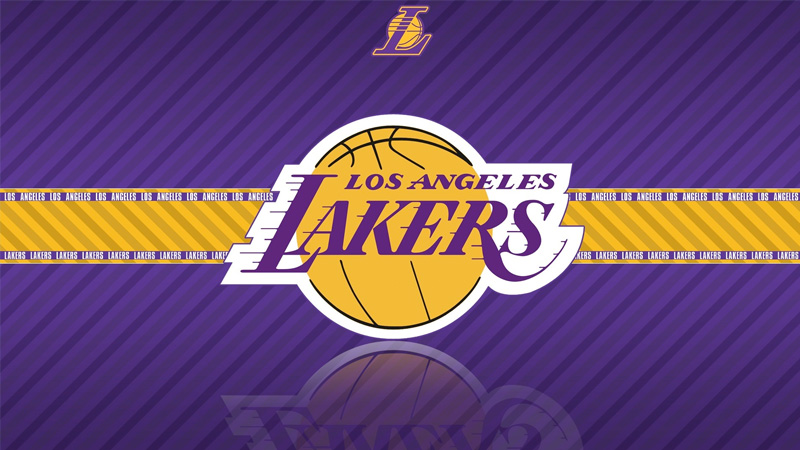
A Look Inside the Lakers Athletic Training Staff
by Mike Trudell

As NBA teams have evolved into massive businesses in their own right, the resources that they pour into the team have grown in kind, and that’s certainly been applicable to team training staffs.
The Lakers are led by head athletic trainer Marco Nunez, who oversees a staff that, for 365 days a year, concerns itself with the health and well-being of each player on the roster.
So when Lonzo Ball sprains a knee, or Brandon Ingram an ankle, a whole series of events are initiated to first try and get the players healthy, and then back on the court as soon as possible.
How do they do it? Well, the Lakers employee two athletic trainers, a strength and endurance director with two assistants, a physical therapist, a massage therapist and a nutritionist, each of whom plays an important role.
To take a closer look, we sat down with six members of the Lakers training staff to explore the varied roles and responsibilities each has towards the ultimate goal of keeping the players on the basketball court.
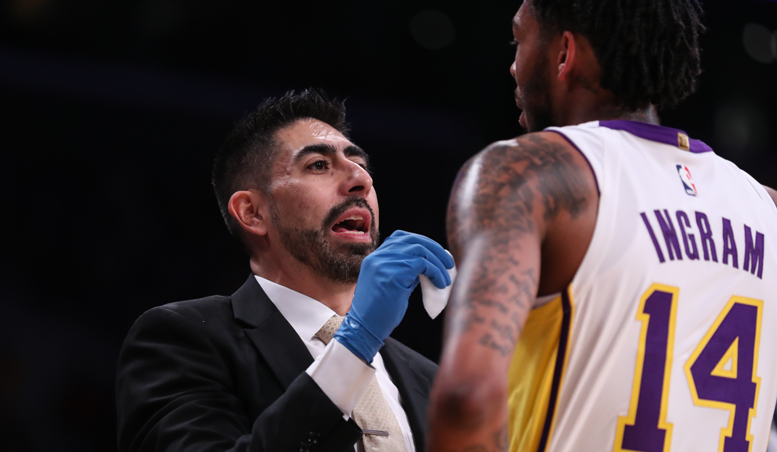
MARCO NUNEZ: Head Athletic Trainer When you think of athletic training, you may visualize the taping of a sprained ankle, or the stretching of a sore hamstring. But as Nunez explained, the majority of what he does is advanced sports science.
The longtime Lakers assistant under Gary Vitti is now in his second season in charge, and in addition to overseeing the strength and conditioning, physical therapy, massage and general athletic training programs, Nunez is in constant communication with the players. He’s scheduling which player needs to see which training staff member at a specific time, figuring out when practice will be and as such who needs to show up before or stay after, deciding when the buses need to leave the hotel, and monitoring the workout sessions, practices and games.
Basically, it’s a never-ending process to stay on top of, but that hasn’t stopped Nunez from expanding what’s been done in the past by adding a full-time nutrition/dietician and implementing a brand new hydration program.
“We had a test run this summer in Las Vegas with the GSSI, Gatorade Sports Science Institute, and we liked the results,” he explained. “We think it contributed to helping us win the summer league championship.”
At the beginning of training camp, Gatorade came to El Segundo and tested each player with sweat analysis, and then created individualized hydration programs. At home games, each player has a bottle with his name on it, containing carbohydrates, electrolytes, sodium and potassium content that the individual requires. Gatorade supplied the Lakers with an individualized scale for the players, who input their four-digit code after stepping on it, to reveal their weight and an ensuing specific number for what their body needs.
“We start hours before the game, so after shootaround, each player has a bottle they have to drink before they leave the facility,” Nunez continued. “As soon as they get to Staples Center, there’s another hydration bottle for the game, and then another one postgame.”
Why did they start doing this? Well, one specific player was constantly complaining of migraines after a game last season.
“Especially on back to backs, it was like clockwork when we’d get onto the plane, and he’d come ask for Tylenol for a headache,” Nunez recalled. “Ever since we started the hydration program, he’s yet to ask us once about it. One of our draft picks also mentioned to us that when he was in college, cramping was a normal thing for him. He almost expected it to happen. That was just the way he was. He came to us the other day and said, ‘So far this season, I’ve yet to cramp during the games.’”
In short, there’s a direct correlation between hydration and recovery, and the Lakers have already seen the direct benefits.
As he tackles his varying responsibilities, Nunez leans on his entire staff, but perhaps nobody more so than his assistant, Nina Hsieh.
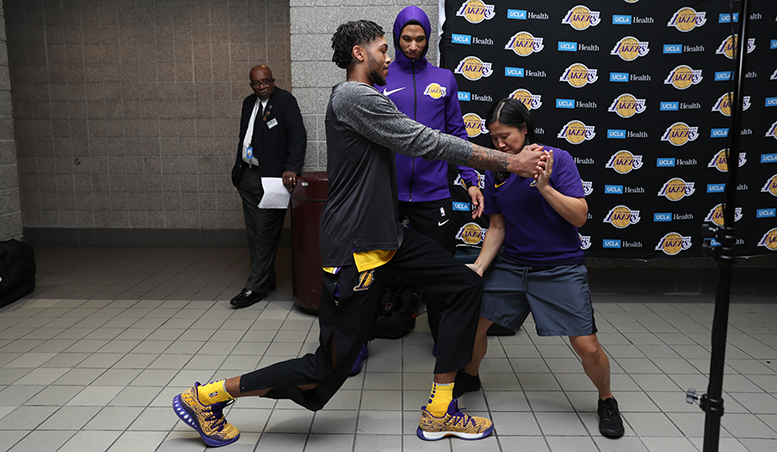
NINA HSIEH: Assistant Athletic Trainer Hsieh was at UC Santa Barbara for four years before being hired as the athletic trainer by the (then) Los Angeles D-Fenders, and spent seven years there while also assisting the Lakers with summer league and training camp, until taking Nunez’s assistant role when Nunez assumed Gary Vitti’s position.
Nunez has built a trust with Hsieh over their 10 years working in the organization, which is paramount.
"Nina reminds me of me when I was in her position as both the head trainer for the D-fenders and as the assistant athletic trainer with the Lakers," he said. "I know that if I need to leave the training room to attend to something else, I have full faith and trust in Nina that everything that I want or expect to be accomplished in the training room with our athletes, will be done."
Nunez knows how to best utilize the position, but also lets Hsieh focus on her own areas of expertise.
“It’s all about the player’s health and their performance on the court for us,” she said. “We try to do a lot of preventative care with our players, and focus on anything that they need on a daily basis. Marco and I focus on many different aspects of sports medicine, whether it’s prevention, emergency care or rehabilitation, or a connection to our team doctors since we’re the liaison for that. We need to do our part, but also lend a hand in everybody else’s department so we can all come together.”
When a player gets hurt, Nunez will decide which of his staffers should work on which specific things for the players based on various areas of expertise.
Hsieh tends to focus the most on ankles and knees, which are the most common basketball ailments, and require quite a bit of maintenance.
If a player tweaks an ankle in practice, he may go see Hsieh right away, particularly if she’s worked on it him the past, and she’ll treat the player and simply make sure to loop Nunez in so he knows what everybody is working on.
Among Hsieh’s other areas of focus is the aforementioned Gatorade hydration project, which she spearheads. She serves as the “Mixologist” who creates the cocktails for the players, so she communicates with the ball boys as to what is needed if a bottle runs out.
“I have all the results of tests we did for each player and what they need for practices and games, and I make their concoction of Gatorade and water so they get the proper amounts of carbohydrates to electrolytes to water for different intensities,” she explained. “We’re hoping that if we continue what we’re doing, we don’t have players experience any of the problems some were having like headaches or cramping.”
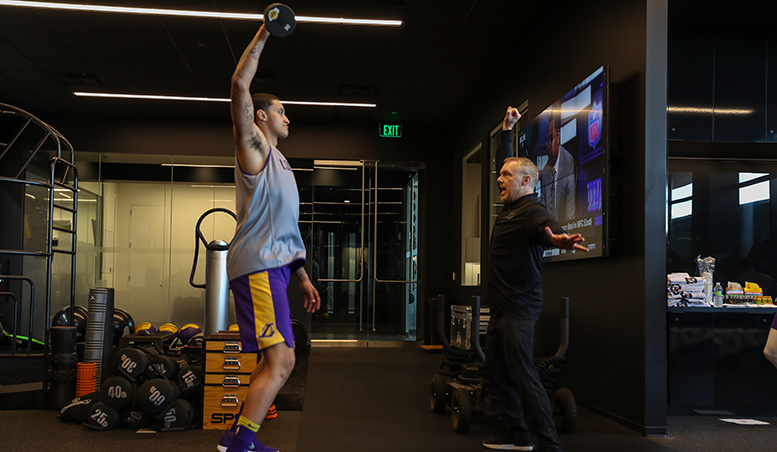
GUNNAR PETERSON: Director of Strength and Endurance Training Over the summer, the Lakers hired an all new strength and conditioning staff, led by 28-year veteran of the fitness industry Gunnar Peterson, who’s been the personal trainer for some of the top athletes and entertainers in the world.
“Gunnar has been a great asset to us,” said Nunez. “We’re in constant communication about the players and we’re seeing some great results.”
“It’s gone really well,” Peterson told us of his first time working specifically with one professional team. “It was a learning process for everyone, but the training protocols pretty much remain the same. We work on explosiveness, quickness, lateral movement.”
Peterson explained that he and his two assistants, Josh Wright and Adi Vase, have the players hold movements like a defensive stance for long periods of time to get the body used to it. They’ll do it under load, or weight, so that when they players are back on the court, it’s an easy adjustment. Peterson noted that it’s hard to run a workout efficiently with a lot of people in a room without the extra pair of eyes and hands, and he really relies on Wright and Vase, two pros who are experts in executing workouts with the players.
Peterson said he’s been working with NBA players for 20 years, but this year has focused more specifically on ankle stability.
“Marco (Nunez) is such a pro, and he gave us tons of information in terms of studies, league findings and research showing that the most common injury is an ankle sprain,” said Peterson. “So we do a lot of stability work on an unstable surface. Reaction to stability. Single-leg stability. That way, in game situations, it’s nothing new and they’re prepared.”
I wondered if it’s any different schedule workouts with players who may have their own ideas about what works for them, as opposed to Peterson’s clients in the past that seek him out and come to his gym.
“They’ve been really diligent,” he countered. “We’ve had over 99% compliance on workouts, meaning we’ve had three people miss workouts all season, and it was all excused.
“I think these guys understand how important strength is. If they didn’t, they only had to be banged around a few times in a few games to understand. They all have the idea of core strength and basic muscle group stuff, but I don’t know if they understand that it translates to career longevity, not to mention things in the present like fewer loose balls given up, fewer turnovers, finishing through contact and things that impact games.”
Like every staff member, Peterson spends a lot of time communicating with Nunez, who will walk across the hall to Peterson’s office and say, ‘This happened to player X this morning, X-Rays are negative but it’s tender,’ so that Peterson can modify the individualized workout for that player. He’ll then run it by Nunez.
“We’re aggressive, but we’re not stupid,” he allowed. “We’ve been in the business long enough to know that a workout plan is a template, not a bible. It’s not worth adhering to something to the detriment of the team. There are no egos on the strength or athletic training side; everybody works really well together.”
STACY ROBINSON: Massage Therapist: Over the past several years, professional teams have increasingly recognized the value of sports massage, and many have hired full-time sports massage therapists who focus on working deep into the muscle tissue.
Nunez met Stacy Robinson 19 years ago when both were working for the L.A. Avengers, an Arena Football League team (2000-2008). She started working with NBA teams in 2006, and Nunez brought her in full time last season.
"Stacy's skills, expertise, professionalism and more importantly, her experience working with other professional teams, made it a no-brainer to hire her," said Nunez. "The trust that I have with Stacey when working with our athletes or when I ask her to focus specifically on an anatomical structure is priceless."
Robinson focuses mostly on the muscle tissue of the players, which requires constant attention.
”With back-to-back games, playing every other day, practice, traveling … you want to make sure the muscles feel good,” she said. “A lot of it is stretching and tissue work. It doesn’t always have to be much, and could be 10 or 15 minutes, but enough time to at least do a flush of the muscle tissue.”
Robinson explained that a flush refers to “the toxins that are being released from regular cell activity,” where as deep tissue work is “realigning deeper layers of the muscles and connective tissues, especially with muscle tightness and stress.”
Deep tissue work can be the key.
“That’s where you’re really getting deep into the muscles, doing joint mobilizations and trigger pointing,” she said. “Before the game, most players just get a flush, which is just different from deep tissue work, which can come after.”
She’ll work on IT bands, glutes, hamstrings, shoulders or traps and the neck. It’s all connected, especially for athletes as active as NBA players. It’s normal for the muscles to tighten up under such duress, but Robinson wants to make sure that tension is in the muscles only, and tries to stay ahead of it by working on the players on a daily basis.
When a player gets hurt, sometimes Nunez will send them to Hsieh or physical therapist Jennifer Swanson (see below) first to do some work before Robinson does her part.
“Sometimes we won’t do tissue work right away, but maybe the modalities,” Robinson explained. “Then the next day, we’ll start doing a flush and look at the joint and what’s going on. Loosen up the tissue.”
One advantage the Lakers have by employing a full-time massage therapist is the ability to get and stay ahead of issues.
“I work on the players every single day, to try to help prevent injuries,” said Robinson. “If I had a former player that came in right now but hasn’t played this season, he’s not going to get much better for three or four sessions. But a current player can get better in a day, because I’m working on that body every day.
“Some days it’ll be the IT bands, the next the glutes and hamstrings, and that makes a difference since it’s consistent. Your muscles can get weak, and sometimes you have to take a day off and get a flush and deep tissue, get stretched, then do nothing the next day and let the muscles heal a little bit.”
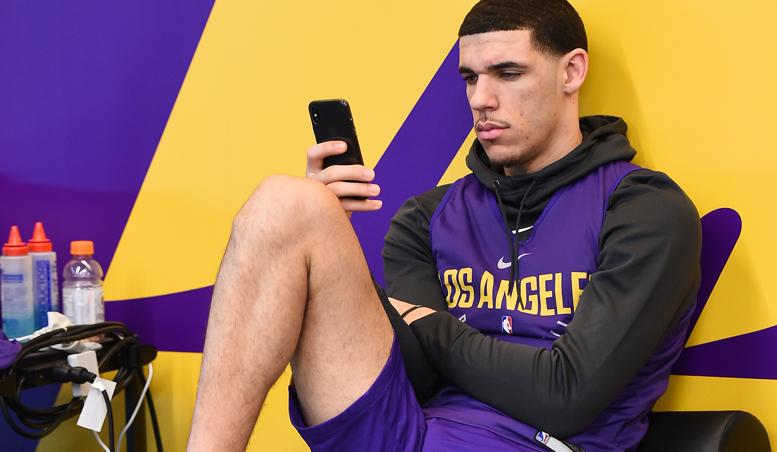
JENNIFER SWANSON: Head Physical Therapist As the Lakers PT, Swanson’s expertise can be utilized in a variety of ways, depending on how many short-term versus long-term injuries the team is experiencing. “You’re looking at long-term rehab, taking players through manual therapy, soft tissue work, joint mobilization into current exercise and part of their strength program,” said Swanson, who was with the Chicago Bulls before coming to Los Angeles.
Physical therapy runs the gamut, with the exception of emergency management that’s required if somebody gets hurt on the court, which is something Nunez would spearhead as the head athletic trainer. Swanson’s work would start as they began the rehabilitation process for that player.
"Jen has grown over the last two years with our organization," Nunez offered. "Her skills and knowledge as a physical therapist are immense." Since PT is most focused on long-term rehabilitation, Swanson is happy if she’s utilized less in that context, meaning the team is healthier. In such cases, she can assist more with injury prevention.
“Before practice, you’re focusing more on injury prevention and performance enhancement,” she explained. “Post practice or postgame would be if anything happened during on-court action, or if there is any continual rehab that needs to be done, or recovery work.”
Many of us regular folk have injuries that have forced us to see a physical therapist, right? The advantage an NBA player has is that he can see his physical therapist every day, which really helps to stay on top of things.
“Frequency that you see them (is important),” said Swanson. “You may see a player three times a day for treatment. They tend to heal a lot quicker, and you have a lot more resources that you’re able to access. The level that you need to get them back to and the urgency to get there is different.”
Part of what Swanson relies upon is the baseline screenings players do at the beginning of the season, in order to track strengths, weaknesses and things to be aware of. One player may have a tight low back due to tight hamstrings or hips, while another may be predisposed to knee tendinitis.
“We’ll look at their injury history and create a plan, so you’re already aware if something comes up, and already working towards those areas,” Swanson concluded.
KRISTEN ANDREWS: Manager of Nutrition and Wellness One of the areas that’s become increasingly en vogue in the last few years for professional franchises is nutrition, and the Lakers took a major step in that direction last offseason by hiring a full-time expert in Kristen Andrews.
“She’s been a great asset,” said Nunez. “Kristen contributes a lot as far as making sure the athletes are consuming the proper calorie count, and paying attention to nutrition before and after games, on the plane and at the hotel.” A registered dietician by training who ran track and cross country at the University of Arkansas before going to graduate school and eventually landing an internship with the L.A. Galaxy, nutrition is Andrews’s main point of emphasis.
She sat down with each player before the season started, one on one, trying to find out what their good and bad eating habits were. Andrews studied the blood tests the players did during physicals to see if there were any deficiencies that needed correcting that could have implications for health down the road, or present a current injury, and recommended vitamins for players that have deficiencies.
“What we’re really looking at is how can we maximize health, maximize performance, avoid injury or decrease amount of time it takes to come back from injury, and avoid sickness,” she said. “All of these things tie in together, and you can’t accomplish any of those things without considering what you’re putting into your body and how it affects you.”
Nunez and his staff have placed an emphasis on recovery, and a proper diet is a key component on that front. As such, Andrews composes recovery shakes for each player that are waiting in their locker after games, which are specifically tailored to their needs.
Since it can be hard to convince an out-of-shape 35-year-old to eat healthy, it can be even trickier convincing a 20-year-old that’s one of the world’s best athletes to really consider everything going into his body.
“It’s tough, especially with the young guys,” said Andrews. “It can be an uphill battle (to convey that) just because you don’t feel something right away doesn’t mean it’s not better for you and can elongate your career and prevent injuries.”
Andrews noted that it’s a bit more challenging with basketball players than soccer players, since soccer is so fitness based, so those players are naturally more open to thinking about what they put into their bodies. Hoopers have a steeper learning curve … but more guys are getting serious about it, and progress is inevitable.
“I think if you look down the road five years, we’ll be in a much different place, and when we get new players, it will be much easier to integrate them into the system,” said Andrews.
The Lakers hired a third-party caterer to get food onto the plane when the team travels, and Andrews OK’s menus after making changes and tinkering before the food is delivered from kitchens across the country. She supplements that food with snacks from Whole Foods, where there’s a healthy medium between things that people want, but also things that don’t do too much damage.
“We make sure to hit all the bases to give guys options where if they don’t feel like chicken, there’s another option where they can get their protein that they need, like beef or fish,” she said. “On game days specifically, carbohydrates are the most important thing, because that’s what they’re going to be using for energy, so at all of our game day meals, there’s a big emphasis on good, quality carbohydrate sources.”
In past years, there was always a dessert available after the main course, but that’s gone away this year.
“We’re just not putting it in front of your face,” Andrews explained. “If you must have ice cream, you can go find it when you get off the plane. We want to make it easier to make the right (healthy) decisions, otherwise, it can be hard to turn something down if it’s right there.” Fact.
WHAT’S NEXT? Marco Nunez is incredibly busy during the NBA season overseeing all that’s been covered in this piece, but he’s also always trying to get a step ahead, and spends some of his little free time researching what’s coming up next in the industry. For example: medical analytics that track player fatigue and stress points and gauge when muscles are getting worn down. So we’ll see what comes next, but we know it will save the same ultimate purpose: keeping players on the basketball court.